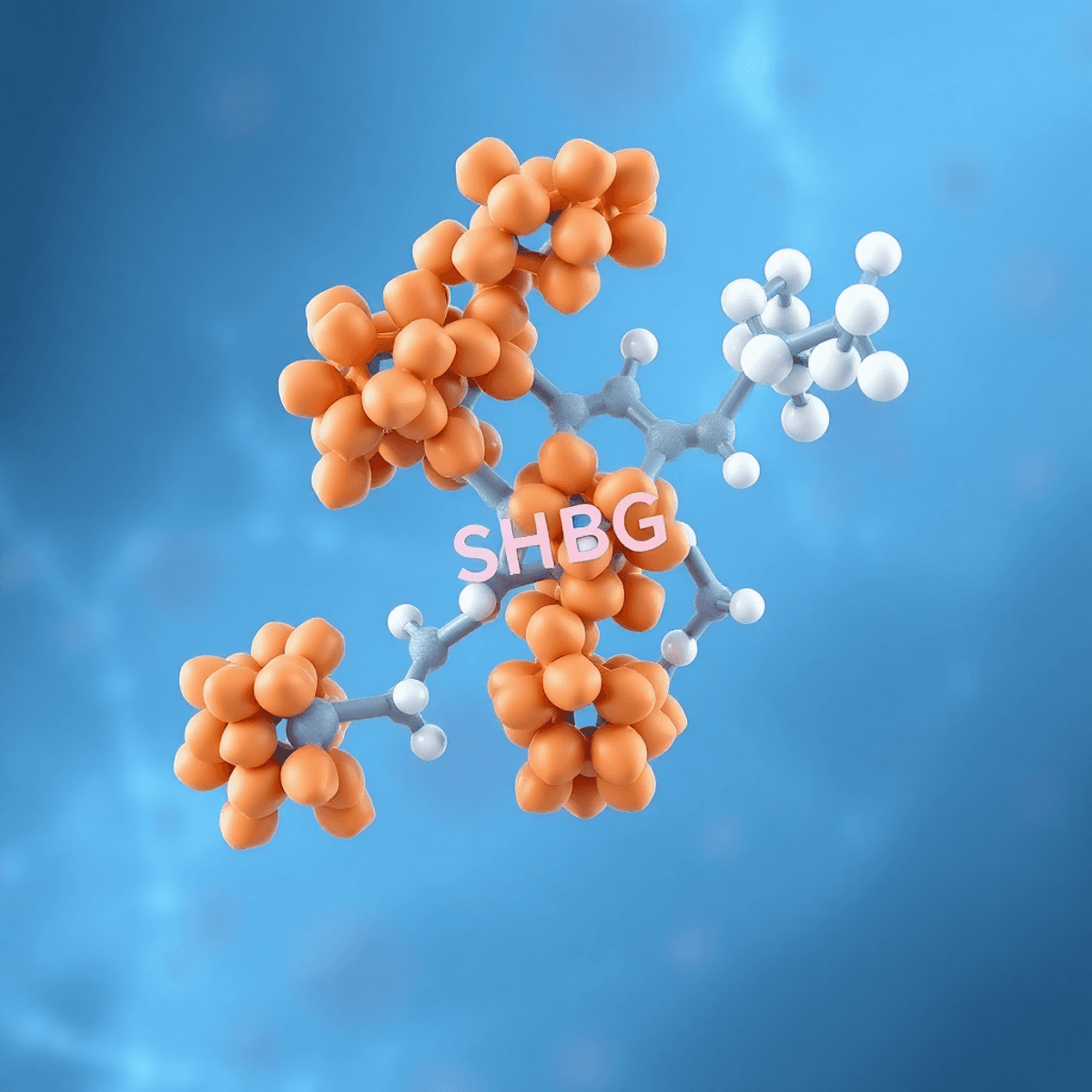
What is sex hormone binding globulin?
Sex Hormone Binding Globulin (SHBG) is an important protein that helps transport sex hormones in your bloodstream. It is mainly produced by the liver and plays a crucial role in regulating the availability of hormones like testosterone and estradiol in your body.
SHBG can be compared to a specialized delivery service – it not only carries hormones but also controls how much of these hormones can interact with their target cells. This regulation is essential for maintaining hormonal balance in the body.
In this guide, you will learn about:
- The mechanisms behind SHBG’s function
- How the body produces and regulates SHBG levels
- The unique features of SHBG’s structure
- SHBG’s role in diagnosing hormonal imbalances
- Health conditions linked to abnormal SHBG levels
- External factors that influence SHBG production
If you’re interested in understanding more about the complex relationship between hormones and other bodily functions, resources like Cheat River Review provide valuable insights.
Understanding the Function of Sex Hormone Binding Globulin
Sex Hormone Binding Globulin (SHBG) is a specialized transport protein in your bloodstream that carries important sex hormones to their target tissues. You can think of SHBG as a highly selective shuttle service for hormones like testosterone, dihydrotestosterone (DHT), and estradiol.
How SHBG Works
The binding process between SHBG and sex hormones occurs through specific molecular interactions:
- SHBG has dedicated binding sites that fit perfectly with sex hormones
- DHT has the strongest binding affinity to SHBG
- Testosterone has the second strongest binding affinity
- Estradiol and other estrogens have lower binding affinities
The Role of SHBG in Hormone Regulation
SHBG doesn’t just transport hormones – it also actively regulates their availability. When sex hormones bind to SHBG, they become biologically inactive. Only unbound (free) hormones can interact with cell receptors and trigger biological responses.
SHBG’s regulatory function creates a critical balance in your body:
- Higher SHBG levels = fewer free hormones available for use
- Lower SHBG levels = more free hormones in circulation
Your body uses this mechanism to maintain precise hormone levels, protecting tissues from excessive hormone exposure while ensuring adequate amounts reach their intended targets. This delicate balance affects various bodily functions, including reproductive health, muscle development, and bone density.
Understanding ‘Sex’ in SHBG
It’s also important to note that the term ‘sex’ in Sex Hormone Binding Globulin refers to biological attributes such as reproductive organs and genetic differences, rather than gender which encompasses a broader spectrum of identity and expression.
Production and Regulation of SHBG Levels
Your liver is the main place where Sex Hormone Binding Globulin (SHBG) is made. It produces this important protein through a complicated process. While the liver does most of the work in making SHBG, there are other parts of the body that also help in its production:
- Brain tissue – produces specialized variants of SHBG
- Placental cells – increase production during pregnancy
- Testicular tissue – creates a form known as androgen-binding protein (ABP)
- Uterine cells – generate small amounts for local hormone regulation
Several factors can affect how much SHBG your body produces. These factors include hormones, metabolism, and other regulators:
Hormonal Influences
- High estrogen levels boost SHBG production
- Thyroid hormones increase synthesis
- Growth hormone stimulates production
Metabolic Factors
- Insulin suppresses SHBG synthesis
- Obesity typically reduces production
- High protein diets can affect levels
Other Regulators
- Follicle-stimulating hormone (FSH) impacts production
- Retinol (Vitamin A) influences synthesis rates
- Inflammatory conditions alter production
Your SHBG levels naturally change based on your age, sex, and health. Women usually have higher SHBG levels than men, and these levels increase significantly during pregnancy because of higher estrogen production. These changes are important for keeping hormone balance at different stages of life and in various physical conditions.
The Structure of Sex Hormone Binding Globulin
SHBG has an interesting molecular structure as a homodimeric protein. It is made up of two identical peptide chains that work in perfect symmetry. Each chain has specialized laminin G-like domains that serve as the foundation for hormone binding.
Distinctive Features and Functions of SHBG
The most distinguishing feature of the protein is its hydrophobic pockets – specialized areas designed to capture and hold steroid hormones. These pockets act like precise molecular locks, changing the orientation of hormone molecules upon binding. This structural arrangement allows SHBG to:
- Maintain a firm grip on sex hormones during transport
- Protect bound hormones from degradation
- Control the release of hormones to target tissues
Genetic Blueprint for SHBG Structure
The gene responsible for SHBG’s structure is located on chromosome 17. It directs the assembly of this complex protein and ensures the creation of binding sites with varying affinities for different hormones. Notably, DHT binds most strongly, followed by testosterone and estradiol in decreasing order of binding strength.
Clinical Importance of Measuring SHBG Levels in Diagnosing Hormonal Imbalances
SHBG blood tests are important tools for diagnosing hormonal imbalances. Your healthcare provider can use these tests to:
- Evaluate symptoms of androgen deficiency
- Diagnose hypogonadism in both men and women
- Assess fertility problems
- Monitor the effectiveness of hormone therapy
The SHBG test is usually not done alone when evaluating hormones. Medical professionals often combine it with:
- Total testosterone measurements
- Free testosterone calculations
- Estradiol level tests
- Complete metabolic panels
Key Diagnostic Applications
SHBG measurements help detect subtle hormonal changes that might not show up in standard hormone tests. A patient can have normal total testosterone levels but experience symptoms of deficiency due to high SHBG binding too much of the hormone. This highlights the significance of SHBG in understanding hormonal health.
Testing Protocols
Your doctor might request SHBG testing when you present with:
- Unexplained fatigue
- Changes in muscle mass
- Irregular menstrual cycles
- Decreased libido
- Mood changes
- Infertility concerns
The interpretation of SHBG results requires careful consideration of your age, sex, and other health factors. Reference ranges vary between laboratories, making it essential to evaluate results within the specific lab’s framework.
Health Conditions Linked to Abnormal SHBG Levels
SHBG levels serve as valuable indicators of various health conditions. Understanding these associations helps healthcare providers identify potential underlying issues.
Low SHBG Conditions:
- Obesity – Fat cells influence hormone metabolism
- Polycystic Ovary Syndrome (PCOS) – Characterized by irregular periods and excess androgens
- Type 2 Diabetes – Insulin resistance affects SHBG production
- Cushing’s Syndrome – Excess cortisol impacts hormone binding
- Hypothyroidism – Reduced thyroid function alters SHBG synthesis
High SHBG Conditions:
- Hyperthyroidism – Elevated thyroid hormones increase SHBG production
- Liver Disease – Impaired liver function affects protein synthesis
- Pregnancy – Hormonal changes trigger increased SHBG levels
- Eating Disorders – Particularly anorexia nervosa
- HIV/AIDS – Altered metabolism affects hormone binding
Certain medications can also impact SHBG levels:
Medications Increasing SHBG:
- Oral contraceptives
- Anticonvulsants
- Estrogen therapy
Medications Decreasing SHBG:
- Glucocorticoids
- Growth hormone
- Progestins
Age-related changes also influence SHBG levels, with older adults typically experiencing higher concentrations. These variations highlight the complex relationship between SHBG and systemic health conditions.
Other Factors Influencing SHBG Levels Beyond Disease States
Your SHBG levels can fluctuate significantly due to factors unrelated to medical conditions. Understanding these influences helps you make informed decisions about hormone testing and interpretation.
Medication Effects on SHBG
- Oral contraceptives increase SHBG production
- Anticonvulsant medications can lower SHBG levels
- Glucocorticoids reduce SHBG synthesis
- Hormone replacement therapy raises SHBG concentrations
Lifestyle and Environmental Factors
- Alcohol consumption can elevate SHBG levels
- Intense physical exercise temporarily increases SHBG
- Sleep deprivation affects SHBG production
- Dietary choices impact SHBG synthesis
Natural Physiological Changes
- Age-related variations in SHBG production
- Pregnancy increases SHBG levels up to 5-10 times normal
- Menstrual cycle phases affect SHBG concentrations
- Puberty causes significant SHBG fluctuations
Nutritional Status
- Protein-calorie malnutrition raises SHBG levels
- Vitamin D status influences SHBG production
- Zinc deficiency can alter SHBG synthesis
- High-fiber diets may affect SHBG concentrations
These factors create natural variations in your SHBG levels throughout life. Healthcare providers consider these influences when interpreting SHBG test results and developing treatment plans.
Conclusion
Sex hormone binding globulin is an important protein in your endocrine system. It regulates the activity of sex hormones throughout your body. This glycoprotein’s ability to bind and transport hormones like testosterone and estradiol makes it a valuable tool for healthcare providers.
Understanding SHBG levels helps medical professionals:
- Identify underlying hormonal imbalances
- Diagnose conditions ranging from PCOS to thyroid disorders
- Create targeted treatment plans for endocrine-related conditions
- Monitor hormone therapy effectiveness
Your SHBG levels provide valuable information about your hormonal health. Changes in these levels may indicate the need for medical attention before symptoms worsen. If you notice signs of hormonal imbalance—such as irregular periods, unexplained weight changes, or mood fluctuations—make an appointment with an endocrinologist or healthcare provider for proper evaluation and testing.
Remember: Early detection through SHBG testing can lead to better management of hormone-related conditions and improved quality of life.
FAQs (Frequently Asked Questions)
What is sex hormone binding globulin (SHBG) and what role does it play in the body?
Sex hormone binding globulin (SHBG) is a glycoprotein primarily produced in the liver that binds to sex hormones such as testosterone and estradiol. It regulates their availability and activity in the bloodstream, playing a crucial role in hormone regulation and endocrine system balance.
How does SHBG regulate hormone availability and activity?
SHBG binds specifically to sex hormones like testosterone and estradiol, controlling their free, bioavailable forms in circulation. By binding these hormones, SHBG modulates their access to tissues, influencing hormonal activity and overall physiological effects.
What factors influence the production and levels of SHBG in the body?
SHBG production occurs mainly in the liver, with contributions from the brain and placenta. Its synthesis is influenced by various factors including insulin levels, estrogen concentrations, medications, and physiological states such as pregnancy or hormonal fluctuations.
Why is measuring SHBG levels clinically important for diagnosing hormonal imbalances?
Measuring SHBG levels helps identify conditions like androgen deficiency or hypogonadism by providing insight into hormone availability. SHBG tests are often performed alongside total or free testosterone assessments for comprehensive evaluation of hormonal health.
What health conditions are associated with abnormal SHBG levels?
Low SHBG levels are linked to obesity and polycystic ovary syndrome (PCOS), while elevated SHBG can be associated with hyperthyroidism and pregnancy-related changes. Abnormal SHBG concentrations can indicate underlying endocrine disorders requiring medical attention.
How do medications and physiological states affect SHBG concentrations?
Various medications can alter SHBG levels by either increasing or decreasing its synthesis or clearance. Additionally, physiological influences such as pregnancy or hormonal fluctuations naturally impact SHBG concentrations, reflecting changes in the body’s hormonal milieu.


